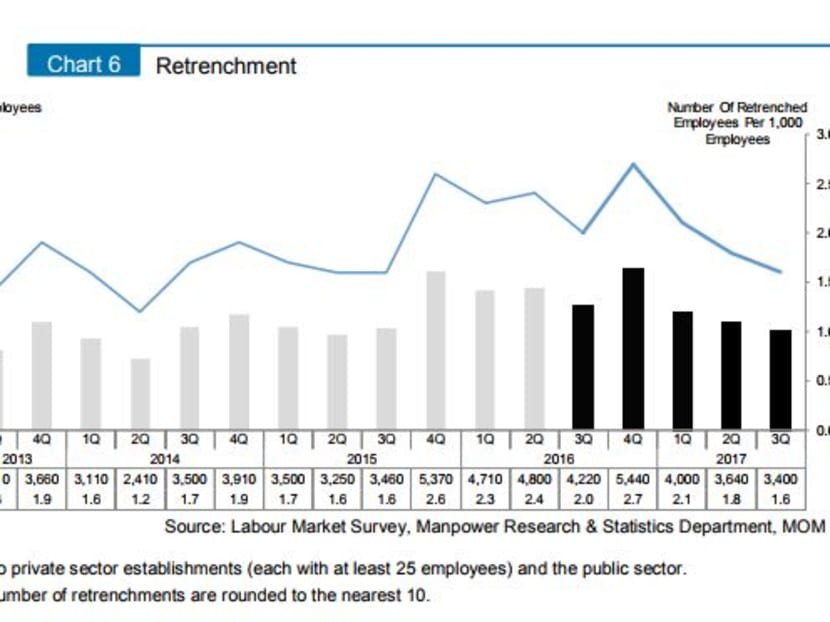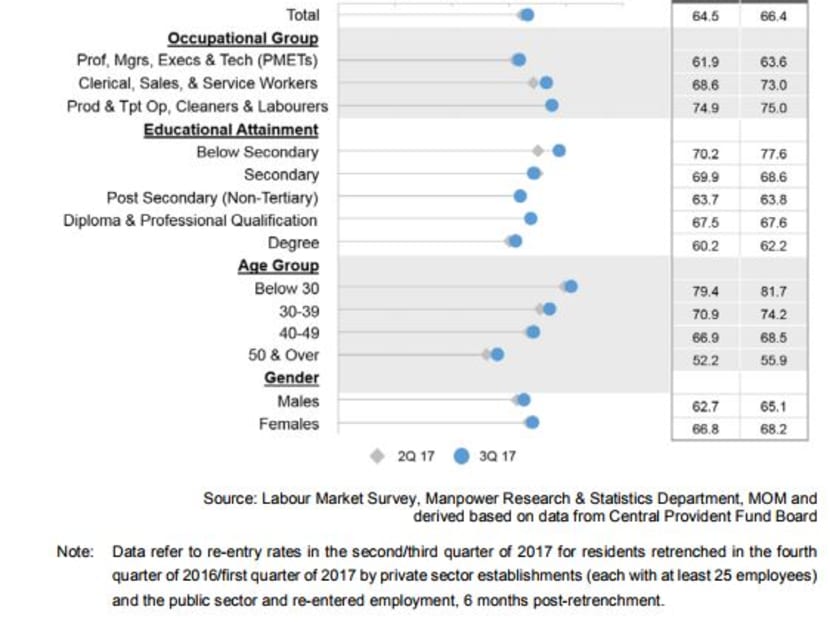Resident employment growth this year set to surpass 2016 figures: MOM
SINGAPORE — The growth in the number of employed Singaporeans and permanent residents this year is likely to exceed the 11,200 recorded last year, even though total employment could shrink due to layoffs in the marine and construction industries, the Ministry of Manpower (MOM) said.
SINGAPORE — The growth in the number of employed Singaporeans and permanent residents this year is likely to exceed the 11,200 recorded last year, even though total employment could shrink due to layoffs in the marine and construction industries, the Ministry of Manpower (MOM) said.
In its labour market report for the third quarter released on Wednesday (Dec 13), the ministry noted that the pick-up in resident employment was mostly due to strong growth in the services sector, which added a total of 26,200 jobs in the first nine months of this year.
The increase in jobs were in four main service sectors: Health & social services (12,000), administrative and support services (4,800), financial services (4,300), and information and communication (3,200).
In the third quarter alone, employment growth in the services sector was 9,200.
MOM said that resident employment is expected to continue to grow next year — in line with the Ministry of Trade and Industry's gross domestic product growth forecast of 1.5 per cent to 3.5 per cent for 2018 — but employment will remain uneven across sectors.
Total employment this year is likely to fall due to continued weak performances in the construction and marine sectors.
In the first nine months, total employment (excluding foreign domestic workers) contracted by 21,400. For the third quarter, it shrank by 2,300, though this figure was more modest than in the previous two quarters, and affected mostly foreign workers in the construction and manufacturing industries.
FEWER RETRENCHMENTS
Broadly, the manpower situation in the third quarter was healthy, with fewer retrenchments and more of those who were laid off re-entering the workforce within six months.
From July to September, there were 3,400 retrenchments, down from 3,640 in the second quarter. As of September, 11,040 workers were laid off, lower than the 13,730 in the corresponding period last year.

A higher proportion of retrenched residents also managed to re-enter the workforce quickly, with about six in 10 managing to get jobs within six months. This is the highest level since the last quarter of 2015 when it was seven in 10.
The highest rates of re-entry were among workers below the age of 30 (82 per cent), and those in jobs that deal with production, transport operations, and cleaning and manual labour (75 per cent).

UNEMPLOYMENT
For citizens, the seasonally adjusted unemployment rate dropped slightly from 3.3 per cent in June to 3.2 per cent in September.
The overall unemployment rate remained unchanged at 2.2 per cent, and at 3.1 per cent for residents.
Economists and human resources experts said that Wednesday's labour report showed that there were signs the labour market is turning around, albeit slowly.
Mr Song Seng Wun, economist from CIMB Private Banking, said: "We are seeing employment patterns reverting to patterns before 2015… local employment is picking up, but the question remains as to whether businesses can upkeep the practice of hiring locals first."
Mr Foo See Yang, managing director of recruitment firm Kelly Services Singapore, said that the latest figures are "reflective of an improving economy", with labour turnover rates holding fairly stable in the past three quarters.
Mr Song added that the retrenchment rate is unlikely to creep up in the fourth quarter because "jobs in the services sector are high in demand during the year-end festive period".
CHANGING JOB ROLES
While the sentiment is that retrenchment figures are unlikely to go up, Mr David Ang, director of corporate services at Human Capital Singapore, cautioned that roles might be changing in workplaces. "I don't think the retrenchment is going to be larger than what we see in the third quarter. There might not be 'retrenchment' in the real sense of the word, but job roles may be redesigned and reconfigured, requiring workers to have digital skills and knowledge," he added.
In the MOM report, it was noted that after a drop in the previous quarter, the seasonally adjusted resident long-term unemployment rate (those unemployed for at least 25 weeks) rose to 0.8 per cent in September from 0.7 per cent in June. This was because unemployment rates went up among residents in their 30s and 40s, as well as those with diploma and professional qualifications.
The slight uptick could be due to the changing nature of the job market and disruptive technologies, human resource analysts said.
Mr Foo's recruitment company, for example, has seen jobseekers being "increasingly open to a wide range of contract roles... to get the relevant experience and expertise for their new career paths".
Mr Mayank Parekh, chief executive of the Institute for Human Resource Professionals, said: "Digital transformation and the increasing use of technology is impacting skills sets, prolonging short-term contracts, and (this) on-demand workforce is changing the nature of job market."
The key challenge ahead is to address the mismatch between skills and jobs available, against the backdrop of a restructuring economy, disruption, and an ageing labour force. The need for workers to acquire or improve their skills and change their mindsets becomes critical, economists said.
Still, they anticipate a relatively rosy job market in 2018.
"If the overall macro-economic outlook continues to remain favourable, with a continued recovery in external demand, labour market conditions should continue to improve," Mr Song said.







